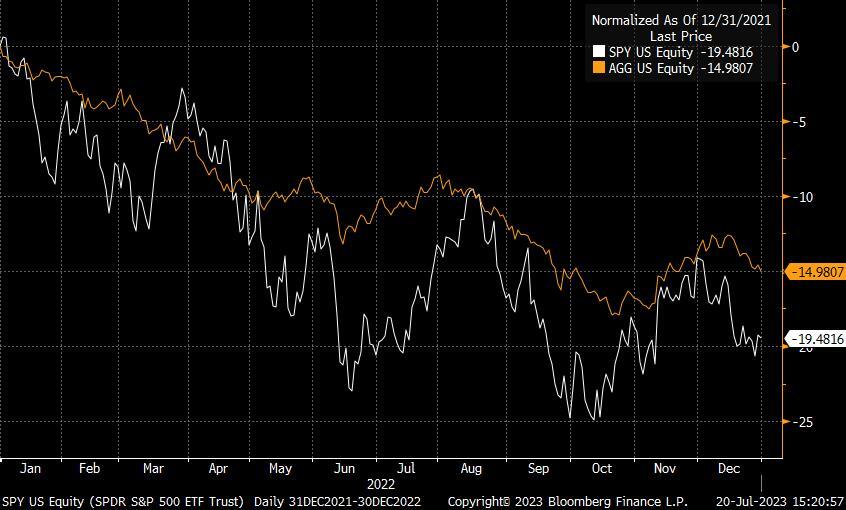With the Fixed Income Symposium taking place on Monday, July 24, the VettaFi Voices gathered at the water cooler to discuss the current state of fixed income markets. After years of ultra-low interest rates and the current ongoing rate hikes, are fixed income markets back to normal? Does fixed income currently fill the role it has traditionally held in portfolios now that we no longer have those ultra-low rates? And what do you see as the most important thing investors don’t understand or are overlooking about fixed income markets?
Todd Rosenbluth, director of research: In 2022, the average bond ETF and mutual fund declined in value. They failed to provide advisors and end clients with the expected capital preservation alternative to equities. However, the iShares Core Aggregate Bond ETF (AGG) is up 3% so far in 2023 and offers a 4% yield. It’s no surprise that fixed income ETFs are gaining traction from both a strategic and tactical perspective. At the mid-year mark, fixed income ETFs had roughly half of the net inflows despite representing one-fifth of the asset base.
ETFs offer liquidity and ease of use benefits to mutual funds. But with the Federal Reserve likely raising rates again next week, uncertainty remains high. That’s one of the reasons there are more than 900 people signed up for VettaFi’s fixed income symposium next week. At this event, attendees will hear from experts from BlackRock, Capital Group, Fidelity, Franklin Templeton, PIMCO, and more. We’re going to talk about rising rates, the opportunities and risks in the credit market, the role active management can play, and more.
ETFs and Active Bond Strategies
As for something advisors likely do not appreciate about fixed income, I think many of them have turned to mutual funds for fixed income exposure. They want active management to make the decisions about interest rates and credit. But in the last few years, many of the best-known active managers and firms have launched active ETFs. The BlackRock Flexible Income ETF (BINC) is run by Rick Rieder of BlackRock, and the DoubleLine Opportunistic Bond ETF (DBND) is run by Jeff Gundlach of DoubleLine. The PIMCO Multisector Bond Active (PYLD) is run by Dan Ivascyn of PIMCO.
Jen Nash, economic and market research analyst: From a historical perspective, the Fed funds rate has not been this high since 2007. That was just before the official start of the “Great Recession.” Currently, the CME FedWatch Tool is predicting a 99.8% chance of the Fed raising rates at next week’s meeting. However, the question remains about another future hike later this year. If rates were to push even further — right now the percentages are saying no, but as we’ve seen, that can quickly change — then we’d be looking at levels seen just before the “dot-com recession” in 2001.
Roxanna Islam Swan, associate director of research: Equities were far too exciting in the past couple of years, so many investors were uninterested in fixed income. We all know about the benefits of diversification. But we also know that by diversifying in a time when equity markets are hot, you will likely miss out on some of the appreciation. Right now, equities are still exciting. However, I think investors are starting to regain some of that caution. They have been trying to get back into fixed income and diversified portfolios.
Fixed Income Basics
Nonetheless, the reality is still that the average investor will be less excited about fixed income. And for those of you that don’t know, I started my research career in fixed income. [From there, I] pivoted to ETFs/CEFs, pivoted to stocks, then pivoted back to ETFs. I understand how hard it can be to talk to investors about fixed income. That’s why ETFs are excellent, in my opinion. You can let someone else do the heavy lifting for you.
There are a lot of good fixed income ETFs out there (including some of the actively managed ones Todd mentioned). That said, sometimes choices can be overwhelming, and there’s nothing wrong with sticking to the basics. If that’s the case, then find a broad one that you like (e.g., AGG, the Vanguard Total Bond Market ETF (BND), etc.) and hold long-term to diversify.
Rosenbluth: I agree with Roxanna on sticking to the basics. Better to have an allocation to fixed income using ETFs for diversification purposes than to invest in only equities regardless of your age. Low-cost core bond ETFs like AGG and BND are great building blocks to a portfolio. If you are still worried about rising rates, then the Vanguard Short-Term Corporate Bond ETF (VCSH) and the iShares 1-5 Year Investment Grade Corporate Bond ETF (IGSB) can provide you more protection and still earn 5% yields.
MLPs as a Source of Income
Stacey Morris, head of energy research: The energy analyst is a dark horse commentator here, but I think it’s a good question of whether fixed income markets are back to normal. Is the period of higher rates going to last for a while? Income is easier to find today, but will that be the case a year or two from now?
Master limited partnerships (MLPs) are not fixed income or bond substitutes. However, they do provide income that is not dependent on the interest rate environment. When the federal funds rate was next to nothing, MLPs were yielding around 8.0%. The Alerian MLP Infrastructure Index (AMZI), which underlies the Alerian MLP ETF (AMLP), was yielding 7.7% as of July 17.
MLPs provide higher yields than corporate bonds, and that clearly comes with additional risk. That said, MLPs can be a nice complement to bonds in an income portfolio with even a modest allocation (maybe 3%–5%) enhancing income and providing diversification.
Rosenbluth: Good point. There’s a lot of income opportunities available via ETFs. We are also covering alternatives to fixed income in Monday’s fixed income symposium. Funds like the Simplify Stable Income ETF (BUCK) and the Innovator Premium Income 10 Barrier ETF – July (JULD) that offer compelling yields without credit or rate risk. Income is not just found in fixed income ETFs.
Dave Nadig, financial futurist: There are really two different things going on with advisors as they’re evaluating the role of fixed income in their client portfolios. On the one hand, having viable yield from bonds is itself a new thing and very useful for managing client cashflows. With funds like the PIMCO Senior Loan Active (LONZ) and others yielding upwards of 8%, there are real opportunities in the space. However, the other big thing going on in advisors’ minds is this chart:
Fixed Income Gut Check
I literally got messages from advisors in the fall of 2022 saying, “How is this possible? This isn’t how stocks and bonds are supposed to work.” It’s why we had all those “Is the 60/40 dead?” discussions. The reality is that having both stocks and bonds just crushed like this shook a lot of advisors to the core.
So the question right now is, if bonds weren’t the ballast in your portfolio before, why would you trust them to be now? (There are of course very simple answers to what happened in bonds last year — duration is a thing, and rates flew higher. Still, it was a big gut check for efficient frontier fetishists.)
Rosenbluth: Duration is definitely a thing advisors need to be mindful of. And they seem to be [thinking about it] based on VettaFi’s Explorer data. Engagement remains stronger for ultra-short-term and short-term fixed income than intermediate- and long-term. There’s still a lot of concern that the Fed is not done raising rates.
Vettafi.com is owned by VettaFi LLC (“VettaFi”). VettaFi is the index provider for AMLP for which it receives an index licensing fee. However, AMLP is not issued, sponsored, endorsed, or sold by VettaFi, and VettaFi has no obligation or liability in connection with the issuance, administration, marketing, or trading of AMLP.
For more news, information, and analysis, visit the Institutional Income Strategies Channel.


